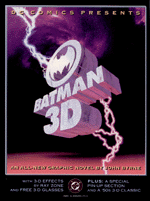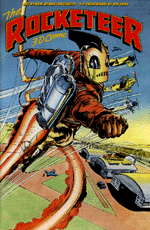

The words "instant collector's item" were never more appropriately applied than to the Batman 3-D book from DC comics. Retailing at $9.95, 70,000 copies vanished in a matter of weeks to the direct market. With much scurrying, DC went back to press for an additional 20,000 copies, which were just as eagerly snapped up. How could anyone resist a graphic novel of the adventures of the Dark Knight written and illustrated by John Byrne with the added pleasure of Ray Zone's extra-dimensional artistry?
"It came about through the initiative of editor Archie Goodwin at DC," explains Zone from his Los Angeles studio, "who had been following my work. He had particularly liked the first issue of 3-D Substance [a Jack Harris and Steve Ditko collaboration] that I put out. Archie Goodwin asked John Byrne, who had scripted a three--part Batman story in 1989, to do a new Batman graphic novel--the first graphic novel length 3-D story--and then he called me to do the 3-D process work."
In his introduction to Batman 3-D. Goodwin explains: "As a comics feature, as a dramatic character and as a visual concept, Batman is particularly well-suited to 3-D. His ominous appearance, his gallery of grotesque villains and the expressionistic heights and depths of his Gotham City locale lend themselves to the extra-dimensional possibilities of the process."
Other artists, including, Alex (Zorro) Toth, Dave (Watchmen) Gibbons, Barry Windsor Smith (noted for Conan the Borbarian), George Perez of Teen Titans fame, Art Adams of X-Men, Jerry Ordway of Superman, Jim Aparo of The Brave and the Bold and others--all first class artists--were contacted to do full page pin-ups to highlight great moments in the history of the Dark Knight and were specifically created for 3-D.
"I don't like to burden artists, who have never worked in 3-D with too many instructions that may hamper their creativity," affirms Zone. "Generally, I just tell them to make things bigger, and think in terms of a dimensional point of view. If there is action I suggest staging the scene along the z-axis-that is, either toward the viewer or back into the depth of the page implied by the perspective.
"Also, exaggerating the perspective and foreshortening a bit-the sort of style that Jack Kirby and Neal Adams use anyway-is appropriate for bringing out the 3-D drama in a scene.
"Everyone has always said that Jack Kirby's art was in 3-D even without having to wear glasses," laughs Zone. "And then, look at some of Neal Adams' cover art. It's the same kind of dynamism--whether it's a hand or a fist--a part of the character comes right at you, then very rapidly falls back and gets smaller as the figure recedes into the background. It's sort of a wide angle lens effect."
For most of the Batman book, Zone kept the 3-D special effects to a minimum and let the images speak for themselves. In the past, it was easy to heighten the feeling of 3-D by having lots of debris, explosions and flames filling the space in a panel, but Zone is able to achieve solid dimensional effects even in the quieter panels.
"Even in a simple headshot, you can have something that's more dramatic than pure action. You can have a drawing of Batman's head with seven or eight levels of dimension and it looks like he's just simply really there.
"It can still be exciting and sensuous 3-D without all the bells and whistles of effects like buildings falling apart in every panel. It's something that Archie Goodwin remarked on when he saw my work: that even the quieter panels had a lot of 3-D."
In the past, some 3-D artists have gotten away with just a suggestion of depth by cutting up a scene into three or four levels, but Zone disdains such shortcuts. Many of his panels have so many levels of depth working simultaneously that he achieves the illusion of full roundness.
"This has been a goal of mine for many years. I attempt to put so many levels into an image that the reader and viewer goes beyond seeing a series of cardboard cutouts, and the image simply looks real. Sometimes the dimensional levels are so complex that the reader attempts to count them, and then simply despairs of being able to see them all," he chuckles. "At this point, the depth is just there, and a kind of magical realism is achieved."
Ray Zone has been working professionally in 3-D graphics now for the past nine years. During that time, he has produced for others or published himself about 100 3-D comic books, as well as hundreds of 3-D conversions for advertising, entertainment and commercial purposes, promoting products from adhesives and insecticides to health plans. In the 1950s, when Joe Kubert and Norman Maurer produced the first Mighty Mouse 3-D comic, using a process of their own devising, about 50 titles were published in six months. Ray Zone's output has doubled that.
Included in the closing pages of the book is a reprint of the Batman 3-D story that was part of the '5Os 3-D boom. "The Robot Robbers" originally appeared in the August/September 1947 issue of Batman (#42). Changes were made to the art and layout when the story was converted to 3-D by DC production manager Jack Adler for the December 1953 Batman Adventures in Amazing 3-D Action. It was reprinted in 1966 when the TV show was at its height of popularity, and now it serves as a solid companion piece to today's vision of the Dark Knight.
Ray Zone makes a strong case for 3-D art as a legitimate medium of expression. For Zone, the illusion of dimensionality springing to life on the page is much more than a "gimmick to sell comic books" as one writer for the Comics Buyer Guide referred to it not long ago. "It's been a personal challenge for me to make people see that 3-D art is actually a very demanding and expressive art form. It's not just a gimmick. It's not just a fad. It's not just a novelty. The whole idea of the graphic novel has had a similar battle--that story and art can address profound aesthetic, social and philosophical issues. The visual expression of these issues, whether in black and white line drawings, four color panels, or three dimensional art can be perceptually, psychologically and visually quite complex."

Last summer, the Rocketeer 3-D comic opened up even more dimensions in this developing medium. It was a total effort in sight and sound. Included in the package was a 48-page 3-D comic version of the Disney film, a pair of Rocketeer 3-D viewers and a binaural audio cassette. The 3-D comic version of the movie was completely different from the 64-page four-color comic that was issued simultaneously. This production was designed for 3-D from the ground up.
"The person most responsible for the general look and effectiveness of the art itself is Mike Royer," asserts Zone. "We met before the book was even laid out in rough form to talk about the best ways to make the 3-D effective. He created page layouts and an adaptation of the script that would be best-suited for the 3-D medium. Then, he gave these page layouts to Neal Adams and Continuity Studios. They finished up the art, and then I processed it to print in 3-D, but it was really the way that Mike laid out the book and the way that the panels inter-relate on the page that underscore that dynamite 3-D effect which I think the book achieved."
The binaural cassette is recorded using a special high-reality technique developed at Bell Labs some years ago. In essence, tiny microphones are placed into the ears of a specially sculpted dummy head. Engineers are then able to record the sounds exactly the way they are heard by human ears. The effect is startlingly lifelike, and seems to actually place you in the center of the action. For best effect, the cassette should be played through headphones.
Together, this unique package of 3-D sight and sound is as close as you can get to cutting-edge Virtual Reality without a computer. And all for only $7.97! *
first published in STARLOG Spectacular number five, 1992.
